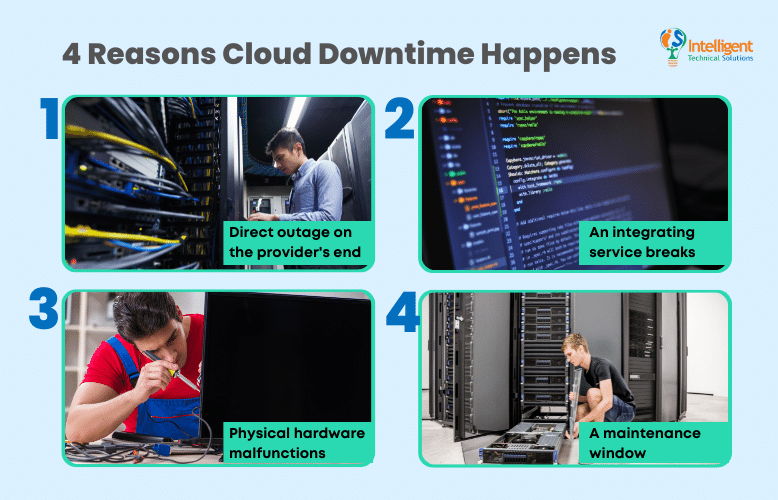Cloud Downtime Explained (& What You Can Do About It)
June 9th, 2022 | 4 min. read

Modern businesses operate in a culture of instantaneous gratification; we're spoiled with immediate access to ideas and resources our ancestors could have only dreamed of. Waiting days or even weeks for information from an international office seems inconceivable.
But our fast-paced connectedness causes tempers to flare easily when data becomes inaccessible. Think about the last time you unexpectedly lost access to a banking app or your business server - you were probably refreshing the page incessantly for a couple of seconds, right?
These bleak periods of frustration are pockets of cloud downtime and are pitfalls of cloud computing.
As a Managed IT Service Provider (MSP), we've experienced our share of cloud downtime. Cloud downtime just comes with the territory of tech management despite all the steps we take to prevent it from happening. In these situations, the best thing to do is to keep clients up to date with what's going on.
And often, they'll ask the following questions:
- What is cloud downtime?
- How long does cloud downtime last?
- Why does cloud downtime happen?
- What steps should you take if you have cloud downtime?
So in this article, we'll answer each of these common questions that you may also have. Each answer will bring your business closer to a cloud downtime-free experience.
Read "Pros And Cons of Cloud For Your Business"
What is cloud downtime?

Cloud downtime is a window of time where users can't access remote data. It's common in businesses using cloud services such as Microsoft Azure, Amazon Web Services, and Google Cloud.
It often has no set schedule and is highly unpredictable. The only exception is a security update that your IT department or service provider schedules. These security updates happen as often as needed - especially if your system collects sensitive information.
Downtime also doesn't have a set amount of time. Whether you wait a minute or a day to regain access to a service or network varies according to why you can't access it. Sometimes, cloud downtime is fixed by quickly restarting your system - other times, you have to wait for patches and software updates to resolve the issue.
According to Uptime Institute's 2022 Annual Outage Analysis Report, downtime frequency, length, and cost have increased. It costs business owners more and more money to bounce back from cloud downtime.
So, why haven't people worked to eradicate cloud downtime?
4 Reasons Cloud Downtime Happens
As much as IT employees would love to keep everything running perfectly 100% of the time, cloud downtimes happen for more than one reason.

These reasons include:
1. Direct outage on the provider's end
Sometimes, it's your provider that has a problem. Do you remember Google being inaccessible for over an hour in December 2020? It made national headlines because of the sheer number of disrupted services: Gmail, YouTube, Google search - the entire world was affected.
Your internal IT team can't do anything in these situations, except for keeping in contact with your provider and updating you about the outage status. That's why choosing the correct cloud service provider is one of your business's most significant decisions. You need someone you can trust.
2. An integrating service breaks
Due to the increase in cloud services, there are cases where software compatibility becomes an issue. It commonly happens when services are phased out, or security updates are implemented.
A perfect example of this is when Microsoft released Windows 10. Hosted cloud providers had to scramble to keep their services compatible with the new OS. Multiple businesses needed to put services on hold due to incompatible code.
3. Physical hardware malfunctions
.Other times, hardware just breaks. Your firewall's power supply gives out, or maybe your old server decides to short circuit. Physical problems like these can stop you from using and accessing your offsite data.
Regaining access involves fixing the malfunctioning hardware, which can take a while depending on the issue with the equipment. You might need to order replacement parts or source an entirely new piece of hardware altogether.
Read “5 Signs You Need to Upgrade Your IT Equipment”
4. A maintenance window
Sometimes, cloud downtime is part of the plan. Your IT department may be practicing proactive IT, and temporarily need to block you from the server while implementing these updates.
Maintenance windows are scheduled downtimes to improve your IT infrastructure and are part of a robust IT process. The most common reason for the maintenance is patching server updates. Maintenance windows happen as often as needed, with companies announcing it in advance.
What should you do when experiencing cloud downtime?
Whenever you can't access your offsite data, follow these steps:
 1. Pinpoint the reason for downtime
1. Pinpoint the reason for downtime
Is there a problem with your provider? Quickly check if the service you're using is down and sit tight for announcements from your provider if this is the case.
If there's no problem with your provider, is there a problem with your equipment? Get your IT staff to check your IT infrastructure systematically. Always be wary of unsuspected outages and check the reason for downtime – you may have compromised data. Some hackers use downtime to sneak into your network.
 2. Inform affected parties
2. Inform affected parties
If your downtime will affect your customer base or multiple people, immediately reach out to them. Inform them of what's happening and when the issue will be resolved. If the problem doesn't have an immediate resolution time, inform them you'll keep sending updates.
If you have scheduled downtime for maintenance, do everything within your power to reach out to potentially affected parties before the downtime happens so they won't be caught off guard.
 3. Wait for downtime to end
3. Wait for downtime to end
At this point, it's either in the hands of your IT department or a third-party provider. Sit tight and wait for your hosted cloud services to run again.
 4. Update affected parties
4. Update affected parties
Once downtime is over, make sure to release an announcement to affected parties that they can access data once again.
Do you need to minimize cloud downtime for your business?
Regardless of the reasons and corrective actions for cloud downtime, ideally, we'd live in a world with no cloud downtime – or at least as few downtime periods as possible. (But because it still happens your IT team must have a robust process that lessens downtime.)
To do that, you need to have a set of configurations that provide the best user experience. An efficient IT department will have a list of standards for your business and a set of actions to take every so often to lessen downtime.
And many of the most efficient IT teams are found with Managed IT service providers.
Don't believe us? Read How Do Managed Service Providers (MSPs) Reduce Downtime? for proof.
Kharmela Mindanao is a senior content writer for Intelligent Technical Solutions. She’s called Ella by her friends and likes yoga, literature, and mountain climbing. Her favorite book is Anxious People by Fredrik Backman. She creates art and poetry and is on a quest to find the best cheesecake.
Topics:
